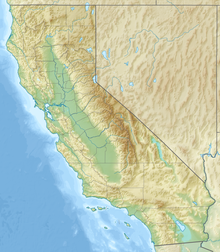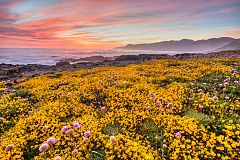| King Range | |
|---|---|
 Beach & surf, King Range National Conservation Area Beach & surf, King Range National Conservation Area | |
| Highest point | |
| Peak | King Peak |
| Elevation | 4,091 ft (1,247 m) |
| Coordinates | 40°09′25″N 124°07′27″W / 40.15694°N 124.12417°W / 40.15694; -124.12417 |
| Geography | |
  | |
| Country | United States |
| State | California |
| County | Humboldt County |
| Range coordinates | 40°09′54.506″N 124°08′3.141″W / 40.16514056°N 124.13420583°W / 40.16514056; -124.13420583 |
| Topo map | USGS Shubrick Peak |
The King Range is a mountain range of the Outer Northern California Coast Ranges system, located entirely within Humboldt County on the North Coast of California.
Much of the mountain range's area is protected within the King Range National Conservation Area, a National Conservation Area unit of the National Landscape Conservation System, and in the King Range Wilderness Area, both managed by the Bureau of Land Management (BLM).
Geography
As part of the Northern Coast Ranges, the King Range runs parallel to the coast, and its western slopes fall steeply to the Pacific Ocean.
The King Range is adjacent to the Mendocino triple junction, where three tectonic plates – the Pacific plate, the North American plate, and the Juan de Fuca plate – meet. The area experiences frequent earthquakes.
Most mountains and ridges in the range are low to moderate in elevation. King Peak, at 4,091 feet (1,247 m), is the highest mountain in the range. Snow falls above 3,281 feet (1,000 m) a couple of times per year.
Climate
| Climate data for King Range Crests, California | |||||||||||||
|---|---|---|---|---|---|---|---|---|---|---|---|---|---|
| Month | Jan | Feb | Mar | Apr | May | Jun | Jul | Aug | Sep | Oct | Nov | Dec | Year |
| Mean daily maximum °F (°C) | 47 (8) |
48 (9) |
49 (9) |
52 (11) |
57 (14) |
63 (17) |
73 (23) |
74 (23) |
72 (22) |
62 (17) |
50 (10) |
46 (8) |
58 (14) |
| Mean daily minimum °F (°C) | 36 (2) |
35 (2) |
36 (2) |
37 (3) |
41 (5) |
46 (8) |
54 (12) |
55 (13) |
52 (11) |
47 (8) |
39 (4) |
36 (2) |
43 (6) |
| Average precipitation inches (mm) | 34.7 (880) |
29.7 (750) |
28.7 (730) |
13 (330) |
5.5 (140) |
1.4 (36) |
0.1 (2.5) |
0.1 (2.5) |
1.0 (25) |
8.2 (210) |
21.4 (540) |
37.0 (940) |
180.8 (4,586) |
| Source: Prism | |||||||||||||
Natural history
The range is part of the Northern California coastal forests ecoregion. It is largely forested with climax-dominant trees including coast Douglas-fir (Pseudotsuga menziesii ssp. menziesii), oak (Quercus garryana and Q. kelloggii), and tanoak (Lithocarpus densiflorus), with pockets of Sugar Pine (Pinus lambertiana) found along steep slopes above the fogline.
The rivers and streams that drain the range include the Mattole River. Four federally endangered species occur in the range: the Coho Salmon, Chinook Salmon, steelhead, and northern spotted owl. Other wildlife includes northern elephant seal, harbor seal, gray whale, brown pelican, bald eagle, peregrine falcon, black-tailed deer, mountain lion, bobcat, osprey, otter, gray fox and black bear.
History
Historically, the King Range was home to the Native American Mattole and Sinkyone peoples. In the 19th century, the region was opened to commercial logging, fishing, ranching, and tanning.
In 1936 and 1937, due to the rugged terrain of the King Range and Mendocino Range to its south, engineers assigned to designing the new State Route 1 were forced to site the highway further inland/east towards the town of Leggett in its route north from Westport. Subsequently, the inaccessible coastal wilderness, known as the Lost Coast, remains the longest undeveloped stretch of coast in California.
In 1970 the U.S. Congress designated 60,000 acres (240 km) of the range as the King Range National Conservation Area. It is primarily located within southwestern Humboldt County, and extends into the far northwestern corner of Mendocino County.
In 2000 President Bill Clinton signed the law designating the rocks and islands just offshore as the California Coast National Monument.
In 2006 the U.S. Congress designated 42,585 acres (172.34 km) of the National Conservation Area as the King Range Wilderness. The California Coastal trail goes from end to end of the range.
Gallery
-
 Wildflowers
Wildflowers
-
 King Range cove
King Range cove
-
 Old ranch and estuary
Old ranch and estuary
-
 Purple sea urchins and Giant Green anemones, King Range tidepool
Purple sea urchins and Giant Green anemones, King Range tidepool
See also
References
- ^ "King Peak". Geographic Names Information System. United States Geological Survey, United States Department of the Interior. Retrieved September 28, 2014.
- "King Range". Geographic Names Information System. United States Geological Survey, United States Department of the Interior. Retrieved May 4, 2009.
- ^ "Environmental Charges Filed For Marijuana Grow On Ecological Reserve". United States Attorneys Office Northern District of California News. U.S. Department of Justice. October 16, 2012. p. 1. Retrieved December 8, 2012.
The King Range National Conservation Area is often referred to as the 'crown jewel' of land protected by BLM and is part of a larger system of national conservation areas, monuments, and reserves protecting nationally-significant landscapes throughout the western United States.
- ^ Xia, Rosanna (August 18, 2022). "Here's where California's cliffs are collapsing into the sea the fastest". Los Angeles Times. Retrieved August 18, 2022.
- U.S. Climate Data. Retrieved April 29, 2022.
- ^ "King Range Wilderness". Wilderness.net. University of Montana. Retrieved December 8, 2012.
External links
- Official Website, Bureau of Land Management
- California Coast Ranges
- Mountain ranges of Humboldt County, California
- Protected areas of Humboldt County, California
- Bureau of Land Management areas in California
- National Conservation Areas of the United States
- Units of the National Landscape Conservation System
- Protected areas established in 1970
- 1970 establishments in California
- Mountain ranges of Northern California